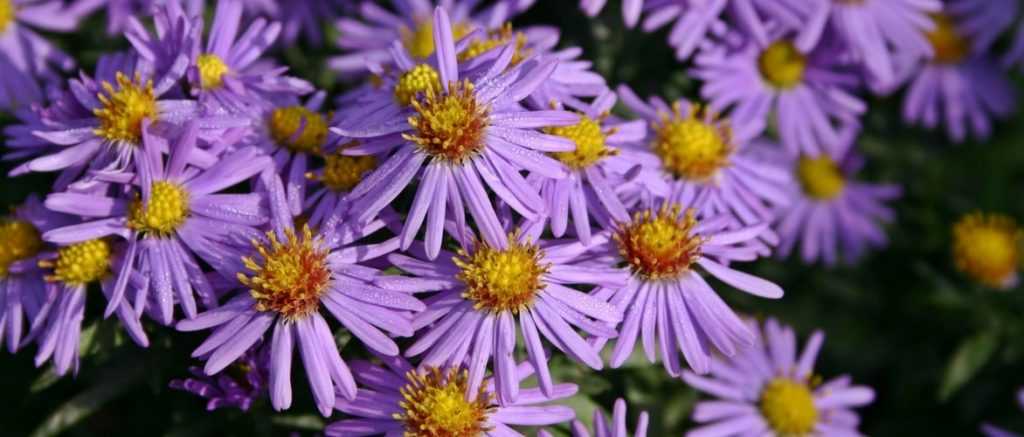
Asters: Planting, Growing and Caring
Contents
Asters in a Nutshell
- Asters brighten up autumn with their generous and colourful blooms!
- Their daisy-like flowers offer a wide range of colours: white, pink, mauve, blue… often with a yellow centre.
- From the smallest varieties to the tallest, they provide great diversity in habit!
- They spread easily, are simple to divide and can even naturalise
- Their airy flowering adds lightness and volume to borders
- They integrate well into naturalistic and wild garden styles
- Asters are ideal plants for well-drained, sunny locations!
Our Expert's Word
Asters are perennial plants that brighten up flower beds in autumn with their colourful blooms! They are the quintessential late summer flower! There are countless varieties, available in beautiful shades of blue, purple, white or pink. Although the most common are the autumn asters, such as Aster novi-belgii (now Shymphyotrichum novi-belgii), there are also spring or summer-flowering varieties, such as the Alpine aster (Aster alpinus). We adore their bright, starry blooms! With their airy and light appearance, tall varieties add great volume when placed at the back of flower beds. Conversely, dwarf asters, like Aster dumosus (or Symphyotrichum dumosum), wonderfully enhance the front of flower beds!
Asters are very hardy autumn perennials and undemanding, making them quite easy to grow. They prefer well-drained soil and sunny positions. Some, like Aster pringlei ‘Monte Cassino’, are an excellent solution for dry and hot areas where other plants struggle to grow. Asters spread easily via their rhizomes and can sometimes naturalise. They are quite simple to propagate by division. The shorter varieties adapt well to container growing or thrive in rock gardens. Asters are quite versatile plants… their only weakness is being susceptible to powdery mildew! But for this, simply choose resistant varieties, such as the New England asters (Symphyotrichum novae-angliae).
Botany
Botanical data
- Latin name Aster sp.
- Family Asteraceae
- Common name Aster
- Flowering autumn. Sometimes spring or summer depending on the variety.
- Height from 20-30 cm up to 1.50 m
- Exposure sun or partial shade
- Soil type light, fresh and well-drained
- Hardiness at least down to – 20 °C
There are nearly 250 species of Asters, mainly perennials, but also annuals or biennials. There are even subshrubs. They primarily originate from North America. A few species come from Asia and Europe. In France, you’ll mainly find Aster amellus, Aster tripolium, Aster pyrenaeus, Aster linosyris (now called Galatella linosyris), as well as Aster alpinus in mountainous regions. Some are protected! The most commonly cultivated Asters are Aster novae-angliae and Aster novi-belgii, two quite similar and hard-to-distinguish species. These are extremely hardy plants: they can withstand temperatures as low as – 20 °C!
They belong to the Asteraceae family. With over 20,000 species, it’s one of the largest plant families. It includes many plants commonly grown in gardens, such as daisies, marigolds or dahlias, but also daisies. It also includes vegetables like artichokes or lettuce.
The name Aster comes from Greek and means Star, referring to the shape of the flowers. Following recent changes in botanical nomenclature, many asters have been renamed as Symphyotrichum or Eurybia. This is particularly the case for North American “asters”. Thus, Aster nova-angliae became Symphyotrichum nova-angliae, Aster novi-belgii is now called Symphyotrichum novi-belgii, Aster dumosus is named Symphyotricum dumosum to name just a few. Aster macrophyllus has become Eurybia macrophylla and Aster divaricatus is now Eurybia divaricata. Although most nurseries still sell these asters under their old names, don’t be surprised to see these curious genus names appearing on labels.
Asters can grow in an upright clump or take on a more spreading habit. Their height varies greatly. Some exceed 1 metre in height. Asters novae-angliae are among the tallest (up to 1.50 m for the variety ‘Violetta’). Others form small cushions, not exceeding 30 cm in height, like Aster dumosus ‘Marjorie’. There’s even a climbing species: Aster carolinianus! Asters often have branched and very sturdy stems, sometimes almost woody.
Asters generally flower in autumn, but there are also varieties with spring flowering (like Aster alpinus) or summer flowering (like Aster sibiricus). Their flowering is very colourful and abundant! They offer a superb palette of blue, mauve and pink. Light and airy, they bring a “cloudy” effect like gypsophila! This is particularly true for Aster ‘Monte Cassino’, which has a multitude of small white flowers.
The flowers are arranged in flower heads, measuring between 1 and 8 cm in diameter, and resemble daisy or marguerite flowers. What appears to be a single flower is actually a multitude of tiny grouped flowers, of two types: yellow tubular flowers in the centre, and ligulate flowers (composed of a long coloured petal) on the outside. Colours vary between pink, violet, blue and white, with petals gathered around a yellow heart. Some Asters offer a striking pink flowering!
The flowering can be single or double. Thus, depending on the variety, the petals (or rather, the ligulate flowers located on the outside of the flower head) are more or less numerous. There are several rows in Aster dumosus ‘Starlight’, giving it a rather sophisticated look, while Aster cordifolius ‘Ideal’ has far fewer. Some varieties have no ligulate flowers: this is precisely what gives the yellow flowers of Aster linosyris their distinctive appearance.
Used as cut flowers, asters bring lightness to bouquets. They last at least a week in a vase. They are also good nectar plants, their flowers attract many insects and butterflies.
Asters have simple and quite fine leaves, except for those of Aster macrophyllus and cordifolius, which are broad and heart-shaped. The leaves are deciduous and arranged alternately on the stem. They are generally green, but can also take on very dark shades, for example purple in Aster laterifolius ‘Lady in Black’.
Asters have rhizomes which allow them to spread widely. Some can even naturalise!
After flowering, asters bear decorative fruits, composed of an achene connected to a pappus of bristles, which allows them to fly away with the wind like dandelion flowers! They have a very light and delicate aspect.

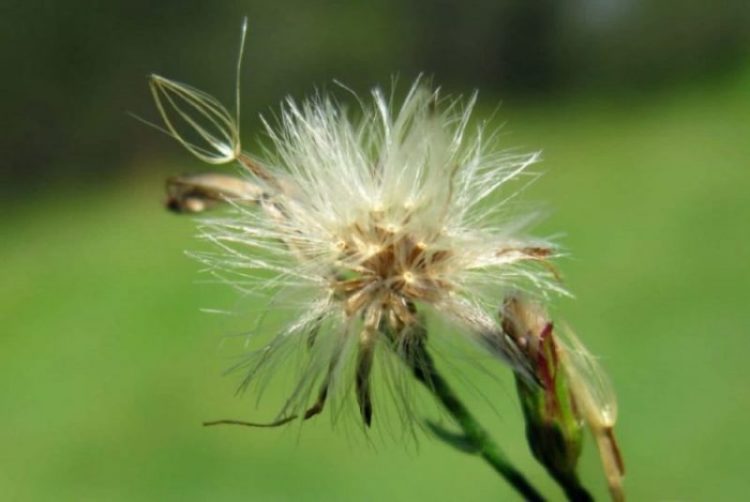
Aster seeds are topped with a pappus that allows them to fly away, to be dispersed by the wind. (here, Aster subulatus – photo Harry Rose)
Botanical species:
- Symphyotrichum novi-belgii or Aster novi-belgii
These are the most common asters in gardens. They flower in autumn, a little earlier than Asters novae angliae. They are also more susceptible to diseases, especially powdery mildew.
- Symphyotrichum novae-angliae or Aster novae-angliae
Commonly cultivated, these asters offer autumn flowering, often violet. They have the advantage of being quite resistant to diseases. They often exceed 1 metre in height. Their flowering is a little denser than that of Asters novi-belgii.
- Aster amellus
This is a medium-sized aster, with summer flowering in blue – violet. It is protected in France. It is also called “Christ’s Eye”.
- Symphyotrichum dumosum or Aster dumosus
Originating from North America, this Aster offers blue – mauve flowering in summer. It is quite compact and forms cushions. It adapts well to pot cultivation! Discover the variety ‘Jenny’, with pink flowers.
- Aster alpinus
The Alpine Aster has the particularity of flowering in spring. With its spreading and quite low habit, it’s a good rockery plant. It has been awarded the Award of Garden Merit by the Royal Horticultural Society (RHS).
Discover asters in video with Olivier:
Read also
Choosing, Planting and Caring for AstersThe main varieties of Asters
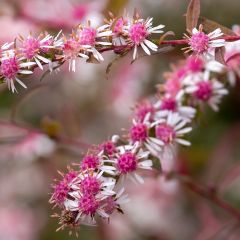
Aster lateriflorus Lady In Black
- Flowering time October, November
- Height at maturity 1,20 m

Aster cordifolius Ideal
- Flowering time October to December
- Height at maturity 90 cm
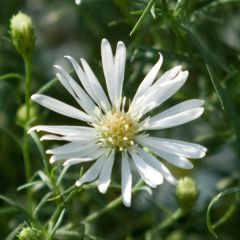
Aster pringlei Monte Cassino
- Flowering time September to December
- Height at maturity 90 cm
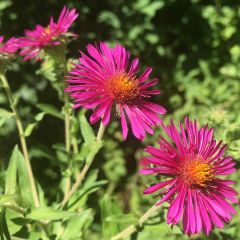
Aster novae-angliae Septemberrubin
- Flowering time September, October
- Height at maturity 1,20 m
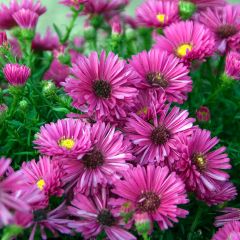
Aster dumosus Jenny
- Flowering time September to November
- Height at maturity 35 cm
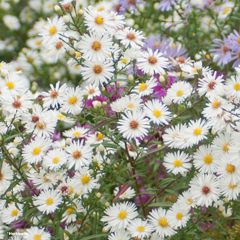
Aster novae-angliae Herbstschnee
- Flowering time September to December
- Height at maturity 1,20 m
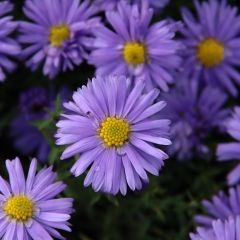
Aster dumosus Lady in Blue
- Flowering time October, November
- Height at maturity 25 cm
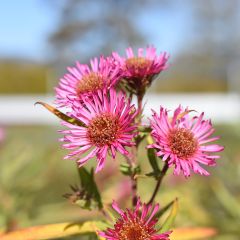
Aster novae-angliae Andenken an Alma Pötschke
- Flowering time October, November
- Height at maturity 1,50 m

Aster cordifolius Little Carlow
- Flowering time October, November
- Height at maturity 90 cm
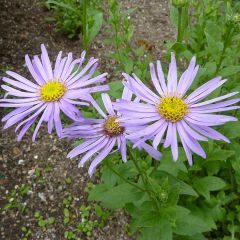
Aster frikartii Mönch
- Flowering time August to November
- Height at maturity 70 cm
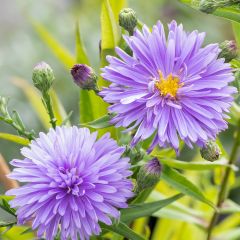
Aster novi-belgii Marie Ballard
- Flowering time October, November
- Height at maturity 1 m
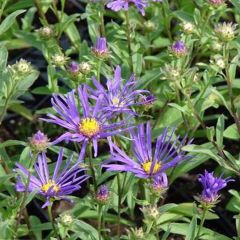
Aster amellus Veilchenkönigin - Violet Queen
- Flowering time August to December
- Height at maturity 50 cm
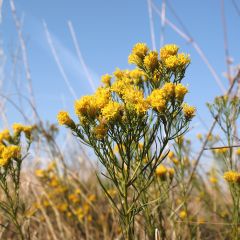
Aster linosyris
- Flowering time September, October
- Height at maturity 60 cm
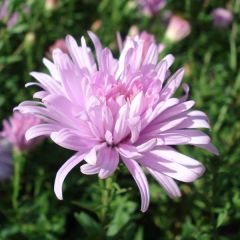
Aster novi-belgii Fellowship
- Flowering time September to November
- Height at maturity 1,20 m
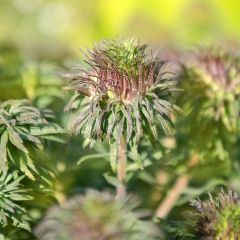
Aster novae-angliae Ann Leys
- Flowering time October to December
- Height at maturity 65 cm
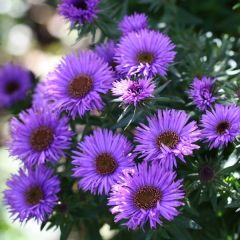
Aster novae-angliae Purple Dome
- Flowering time October, November
- Height at maturity 1 m
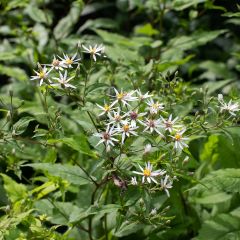
Aster divaricatus
- Flowering time October to December
- Height at maturity 50 cm
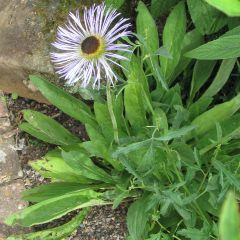
Aster diplostephioides
- Flowering time July to September
- Height at maturity 30 cm
Discover other Asters
Planting asters
Where to plant?
Plant your asters preferably in full sun! Some varieties appreciate a slightly shaded position. The species best suited to shade is Aster divaricatus (or Eurybia divaricata): don’t hesitate to plant it in woodland areas. Most will thrive in well-drained soil, but that remains cool in summer. They dislike excessive moisture in winter, as waterlogged soil could cause root rot. If your soil is heavy, add compost to lighten and enrich it.
Some prefer well-drained, rather dry, and sunny soils. This is generally the case for compact varieties that thrive in rockeries. The most suitable for this purpose are Aster amellus, Aster alpinus and Aster tongolensis. Conversely, other varieties prefer rich, cool soils in partial shade. Thus, Aster novae-angliae enjoys cool, even moist soils. Avoid overly sandy soils that dry out quickly. They appreciate soils rich in humus. This is why we recommend adding organic matter. Generally, asters tolerate chalky soils quite well.
Place taller varieties like Aster tataricus ‘Jindai’ at the back of borders, while smaller ones like Aster ‘Wartburgstern’ or Asters dumosus (or Symphyotrichum dumosum) are perfect for adding colour to the front of borders or edges!
If you wish to grow them in pots, choose the most compact varieties. Aster dumosus is particularly suitable! Discover the ‘Jenny’ variety with bright pink blooms. Asters planted in containers will require more regular watering than those in open ground.
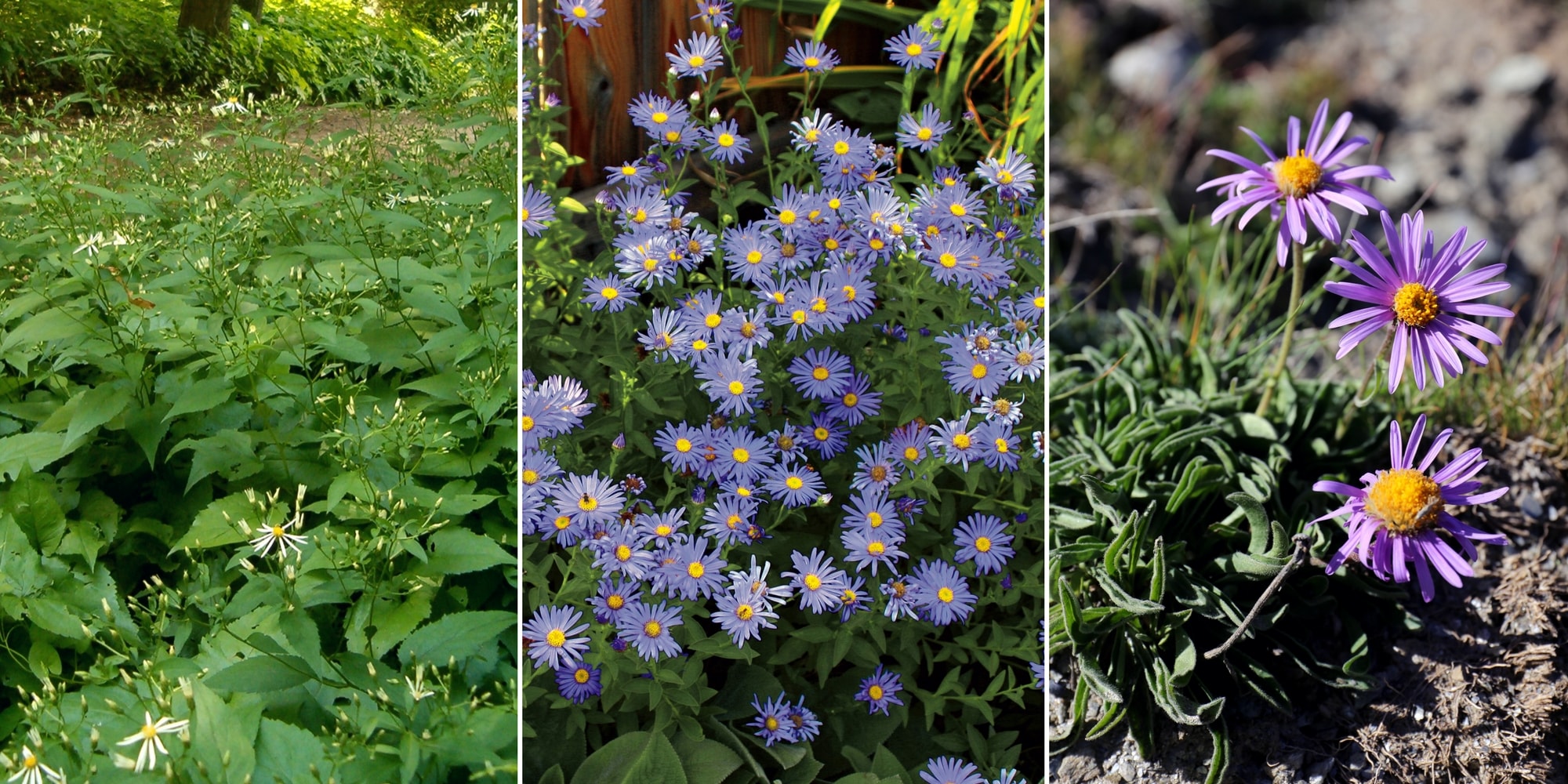
Aster divaricatus will appreciate being planted in woodland, Aster novi-belgii ‘Lady in Blue’ will thrive in borders, while Aster alpinus is better suited to rockeries.
When to plant?
We recommend planting asters in autumn, although it’s also possible to do so in spring.
How to plant asters?
- Moisten the root ball by placing it in a container filled with water
- Dig a planting hole, deep enough to be two to three times the size of the root ball.
- Add compost to enrich the soil.
- Place your aster, fill in around the root ball, then gently firm the soil.
- Stake the tallest varieties.
- Water generously.
- Apply mulch to keep the soil cool and limit weed growth.
Continue watering for the first few weeks, and as needed during summer.
The planting distance varies considerably: from about twenty centimetres for the most compact varieties (e.g. Aster dumosus) to 40 or 50 cm for the tallest. By respecting sufficient planting distance, you’ll obtain more vigorous plants and less susceptible to diseases, as good air circulation limits their occurrence.
→ Learn more in our advice sheet: Growing Asters in pots
Maintenance
Easy to grow, asters are low-maintenance plants. It’s best to stake the tallest varieties, such as Aster cordifolius and Aster novae-angliae, to prevent them from toppling over in wind or rain. Also add some compost each year in early spring. We recommend mulching, especially in summer, to keep the soil cool. Some watering will be necessary during summer droughts. When watering, direct the flow towards the base of the plant, avoiding splashing the foliage, which could encourage diseases (powdery mildew). If grown in pots, water regularly as the substrate dries out faster than in the ground, and apply liquid fertiliser during summer. It’s important to divide asters at least every four years to rejuvenate and aerate the clumps. You can remove spent flowers as they fade to prolong flowering and prevent self-seeding.
Asters are quite susceptible to powdery mildew, especially Aster novi-belgii (Symphyotrichum novi-belgii). We advise applying a preventive treatment during summer, such as sulphur or horsetail manure. This disease thrives in dense plantings, confined spaces (good air circulation is needed) and shady spots. To avoid it, plant your asters in full sun and keep the soil moist in summer. Also favour Aster novae-angliae varieties, which are far less susceptible.
Asters can sometimes be affected by rust, which appears as discoloured leaf spots and rust-coloured pustules on the undersides. They are also prone to downy mildew. Humidity encourages these diseases; Bordeaux mixture and horsetail manure are quite effective remedies. We also suggest removing damaged parts to limit spread. Generally, to protect your asters from disease, plant them in well-drained soil, avoid overcrowding and refrain from wetting the foliage. Waterlogged soil makes them more disease-prone.
Slugs and snails enjoy nibbling young aster leaves. As prevention, you can create barriers using wood ash or sawdust around plants. Sometimes aphids also attack asters.
We recommend pruning asters in June by pinching back the stems (Chelsea chop). Cut stems back by half using secateurs. This encourages better flowering, bushier and more compact growth, while improving air circulation to reduce disease risks (powdery mildew). Similarly, in early winter when stems have dried, it’s best to cut them back to ground level. In colder regions, wait until late winter as the stems protect the plant from frost.
Tall asters often need staking – discover how in our video on easy aster staking.
Propagation
Asters propagate quite easily. We recommend doing so by division, a technique that will ensure you quickly obtain new plants identical to the original variety, unlike sowing.
Dividing Clumps
Division is the best technique for propagating asters. Do this every three years for Asters dumosus, novi-belgii, novae-angliae, and x frikartii. Preferably carry this out in spring, around April, though division is also possible in autumn.
Dividing asters helps to rejuvenate the clumps and make them more vigorous. This will help control their spread, preventing them from encroaching on space to the detriment of other plants. Additionally, it aerates the clumps and prevents powdery mildew by improving air circulation.
Identify the asters to be divided, then cut back the dry stems to ground level. Dig up the clump with a spade. Divide the rootstock into several sections, ensuring each has enough roots and several young shoots. Replant and water generously. We recommend applying mulch to keep the soil cool.
Watch our video guide – Dividing an Aster:
Taking Cuttings
You can take cuttings from aster stems in spring.
- Start by preparing a pot filled with a mix of compost and sand.
- Take a stem cutting, about 10 centimetres long. Cut it at the base just below a node (the point where leaves attach to the stem).
- Prepare the cutting by removing the leaves at the base. Leave just a few leaves at the top of the stem.
- Make a hole in the substrate with a thin stick or pencil.
- Place the cutting in the hole, then firm the substrate around the stem to ensure good contact between the plant and the substrate, avoiding air pockets.
- Water
- Place the pots in a bright spot, out of direct sunlight.
Keep the substrate moist but not overly wet while the cutting roots. Wait until autumn to plant the young plants in the ground.
Sowing
Many aster varieties self-seed readily, sometimes to the point of becoming almost invasive. You’ll quickly get a large number of seedlings, but they can be easily removed by pulling them up.
Sow your asters in spring, either directly in the ground or under cover to plant them in their final position in autumn. Hybrids are sterile.
Prepare pots by filling them with compost and gently firming the surface. Sow the seeds, then cover with a thin layer of compost. Water and place the pots under cover. Keep the substrate moist until germination, which should occur within one to two weeks. In autumn, you can transplant the seedlings into the ground.
→ Learn more about propagating asters with Ingrid’s tips in our tutorial.
Pairing asters
With their airy habit and delicate, light blooms, asters pair wonderfully with ornamental grasses (such as stipa, miscanthus or pennisetum). The taller varieties create a beautiful wild meadow effect.
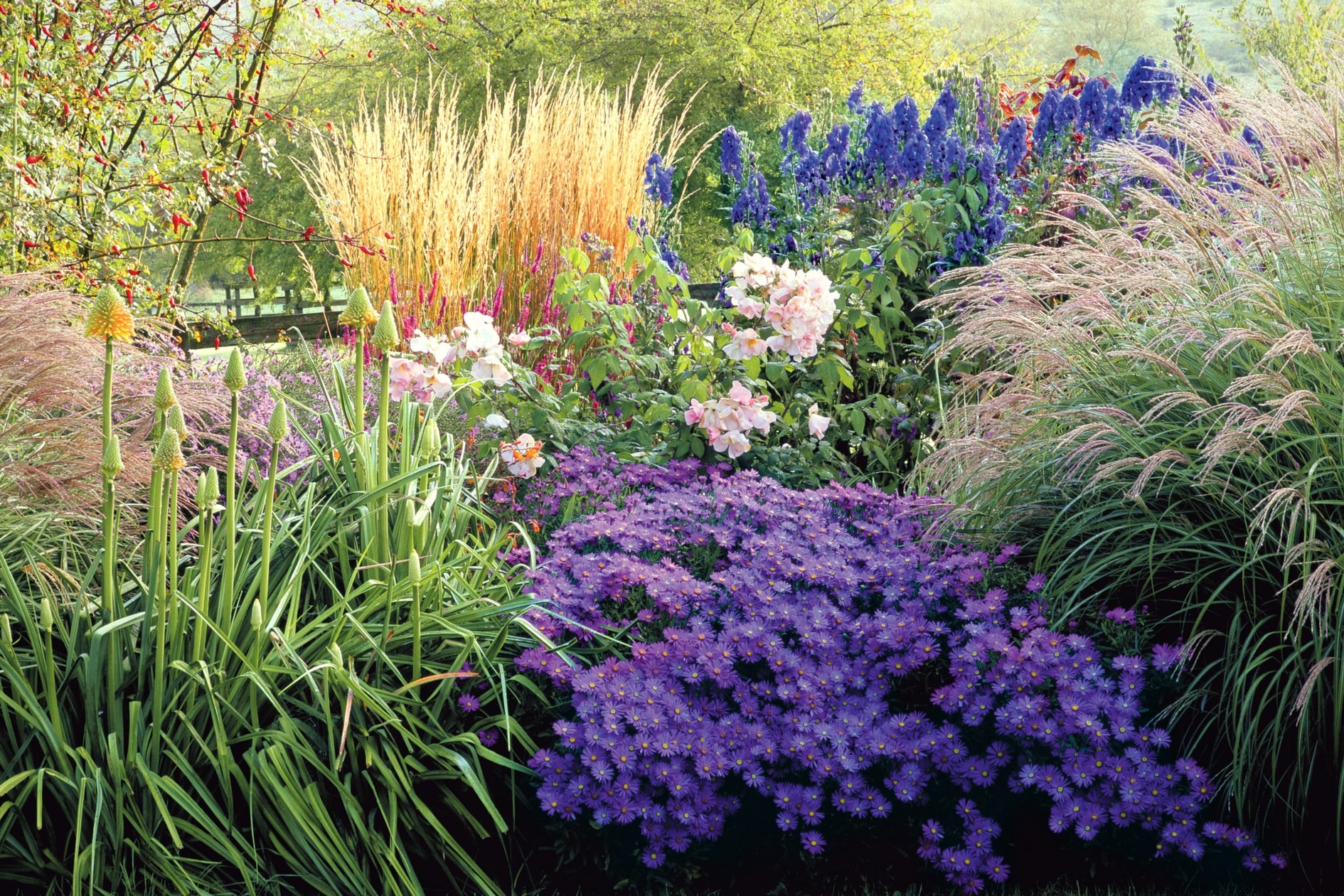
A beautiful combination with ornamental grasses! Aster ‘Sonora’ with Calamagrostis ‘Karl Foerster’, Aconitum carmichaelii ‘Arendsii’, Kniphofia and Miscanthus. (copyright MAP – Clive Nicholspettifers Garden Oxfordshire)
Asters easily fit into colourful mixed borders, alongside other perennials and shrubs. The shorter varieties enliven the front of beds, while taller ones add volume at the back. For borders, consider Aster lateriflorus ‘Horizontalis’, forming a low, spreading clump covered in small white and purple flowers in autumn. Plant them with ornamental grasses, hardy geraniums or yarrows.
Asters brighten autumn with their colourful blooms! Create a stunning autumn display in warm tones ranging from purple, pink, orange to red. Incorporate ornamental grasses, coneflowers, clumps of Sedum spectabile or Argentinian vervain into such borders.
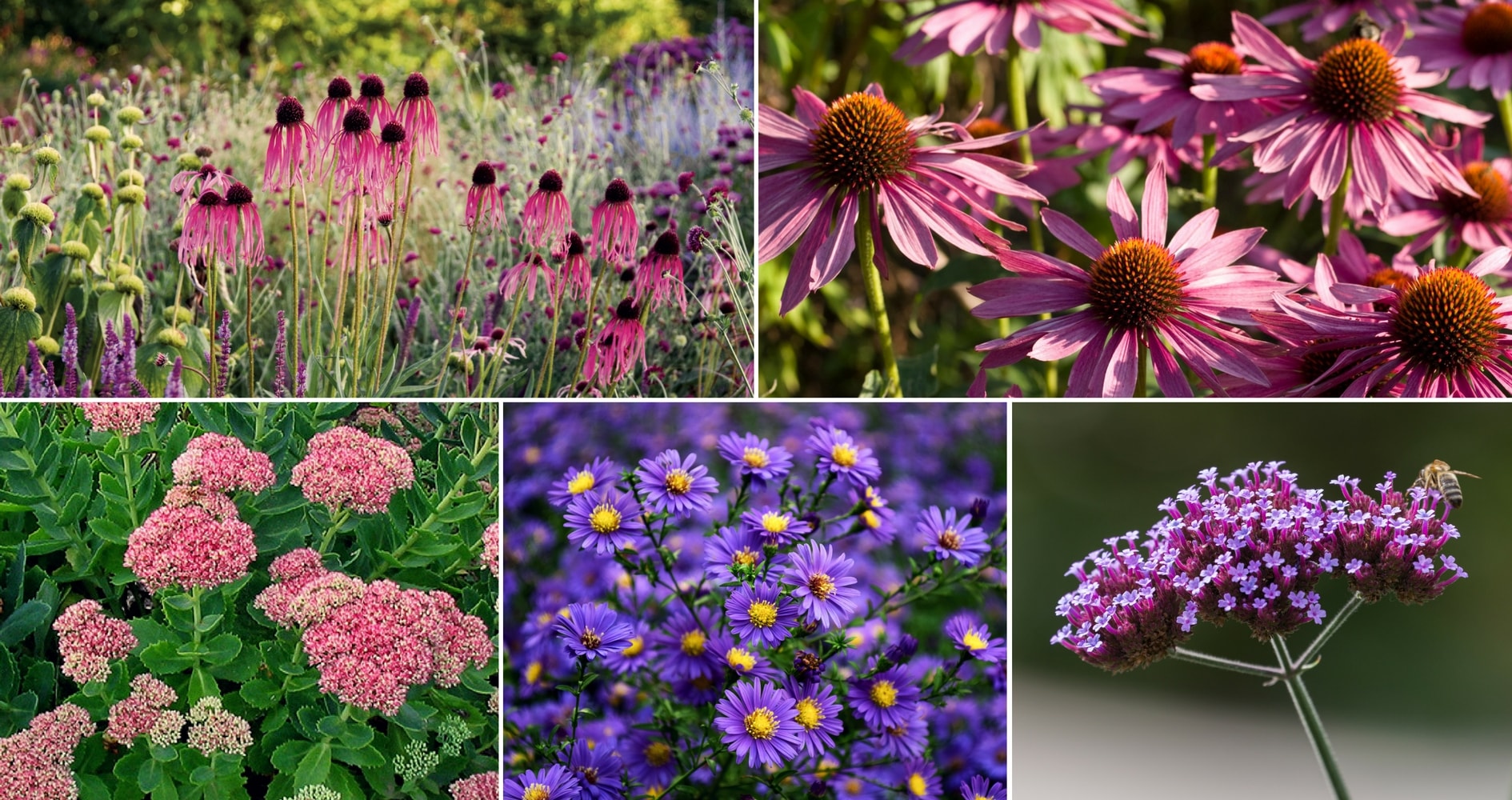
Asters are perfect for creating autumn borders! Echinacea pallida (photo credit GAP Jo Whitworth), Echinacea purpurea ‘Magnus’ (photo Peter Rosbjerg), Sedum ‘Herbstfreude’ and Verbena bonariensis.
Some asters thrive in rock gardens, like Asters alpinus and amellus, suited to dry, sunny spots. Pair them with sedums, houseleeks or small grasses like Stipa tenuifolia. Conversely, Aster divaricatus prefers woodland settings, where it complements ferns and hostas.
For more inspiration, see our guide: “10 Ways to Pair Asters”
Useful resources
- Find the finest range of Asters with us!
- Our advice sheets: Choosing, planting and caring for Asters and 10 ideas for pairing Asters
- Our video tips – Planting perennials
- Our video tips – Dividing an Aster and Asters
- Video – How to grow and divide Asters
- An article by Michael on our blog: Asters: choosing, pairing and succeeding with them!
- An article by Pierre on our blog: Aster ageratoides ‘Ezo Murasaki’, one of the most beautiful late-season perennials!
- Our videos: Stéphane’s favourite Asters and Stéphane’s tips for staking Asters
- Our tutorial: How to stake an Aster? Techniques and advice
- Our advice sheets: Asters: the most beautiful varieties; The best pink Asters to brighten up your autumn garden
- Our advice sheet: Drought-resistant Asters
- Our advice sheets: Dwarf Asters: compact flowers for small gardens and balconies and Giant Asters: perfect for bringing your autumn garden to life!
- Our advice sheet: Disease-resistant Asters
- Our advice sheets: 7 early autumn Asters and 7 double-flowered Asters
- Our advice sheet: The best Aster varieties for bouquets
Frequently asked questions
-
The foliage of my Asters is covered in a white powdery coating! What should I do?
They are affected by powdery mildew. Avoid shady locations: plant your asters in full sun instead. This disease is encouraged by a combination of heat and stagnant moisture. To remedy this, remove affected leaves to limit the spread of the disease, and spray with sulphur. This disease frequently affects Aster novi-belgii. We recommend opting for Aster novae-angliae instead, which are more resistant. As a preventative measure, treat with sulphur or horsetail manure tea. When watering, avoid wetting the foliage.
-
The foliage of my asters is marked with brown and yellow spots
Your asters are affected by downy mildew. You may also notice a white, fuzzy coating on the underside of the leaves. Heat, humidity, and overly dense planting encourage this disease. As with powdery mildew, Aster novi-belgii are the most susceptible. You can treat with Bordeaux mixture or baking soda. For prevention, choose resistant varieties, ensure you have cool, well-draining soil, and maintain adequate planting distances.
-
It's early April and my aster doesn't seem to be regrowing, is it dead?
No, this is completely normal, as asters are late-emerging plants, often appearing around April or even in May. Be patient, you'll soon see them start to grow!
-
My aster is thinning out at the centre of the clump
As asters tend to spread through their rhizomes, it often happens that after a few years the centre of the clump becomes bare. At this point, they should be divided. We recommend doing this at least every three years, in spring. Dig up the clumps using a spade, then separate them into several sections, ensuring each has enough roots. Replant them and water well.
- Subscribe!
- Contents


































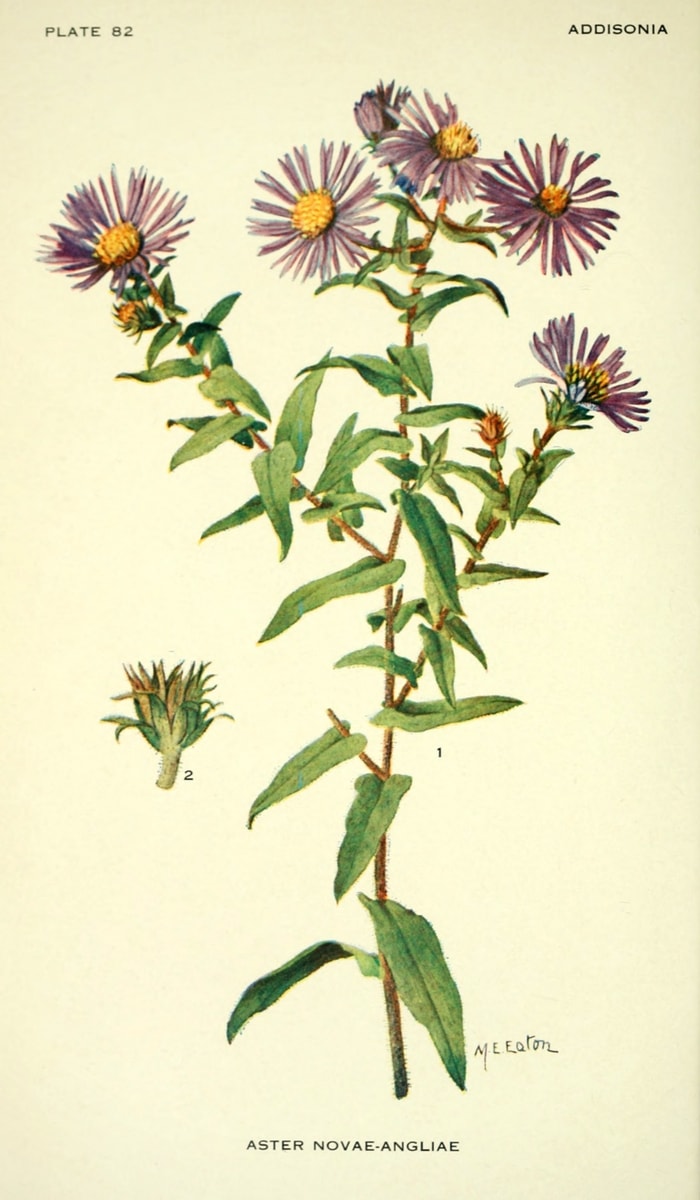
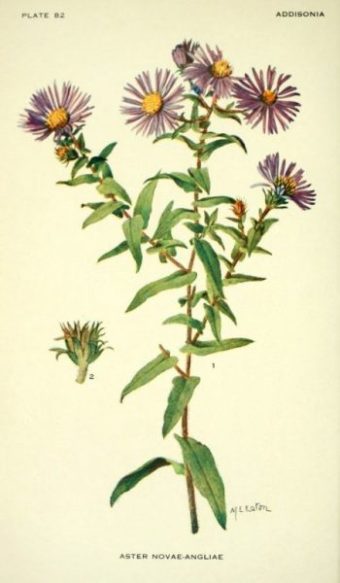


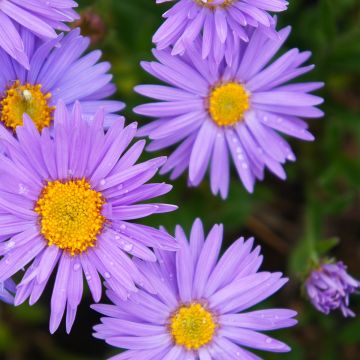
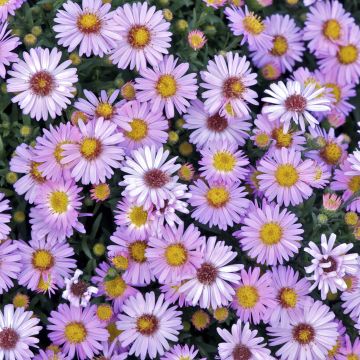


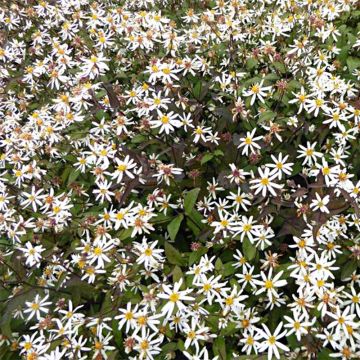



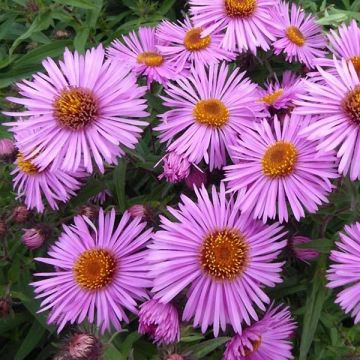

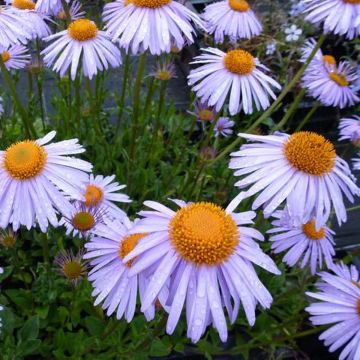
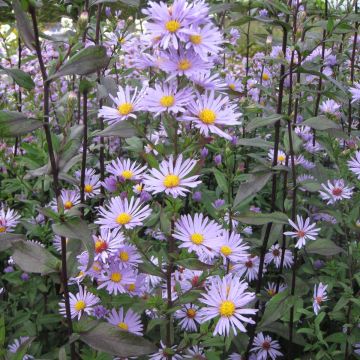

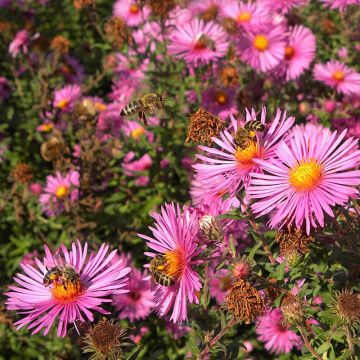
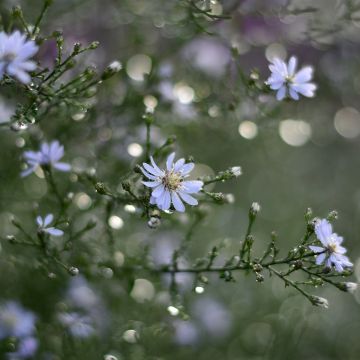
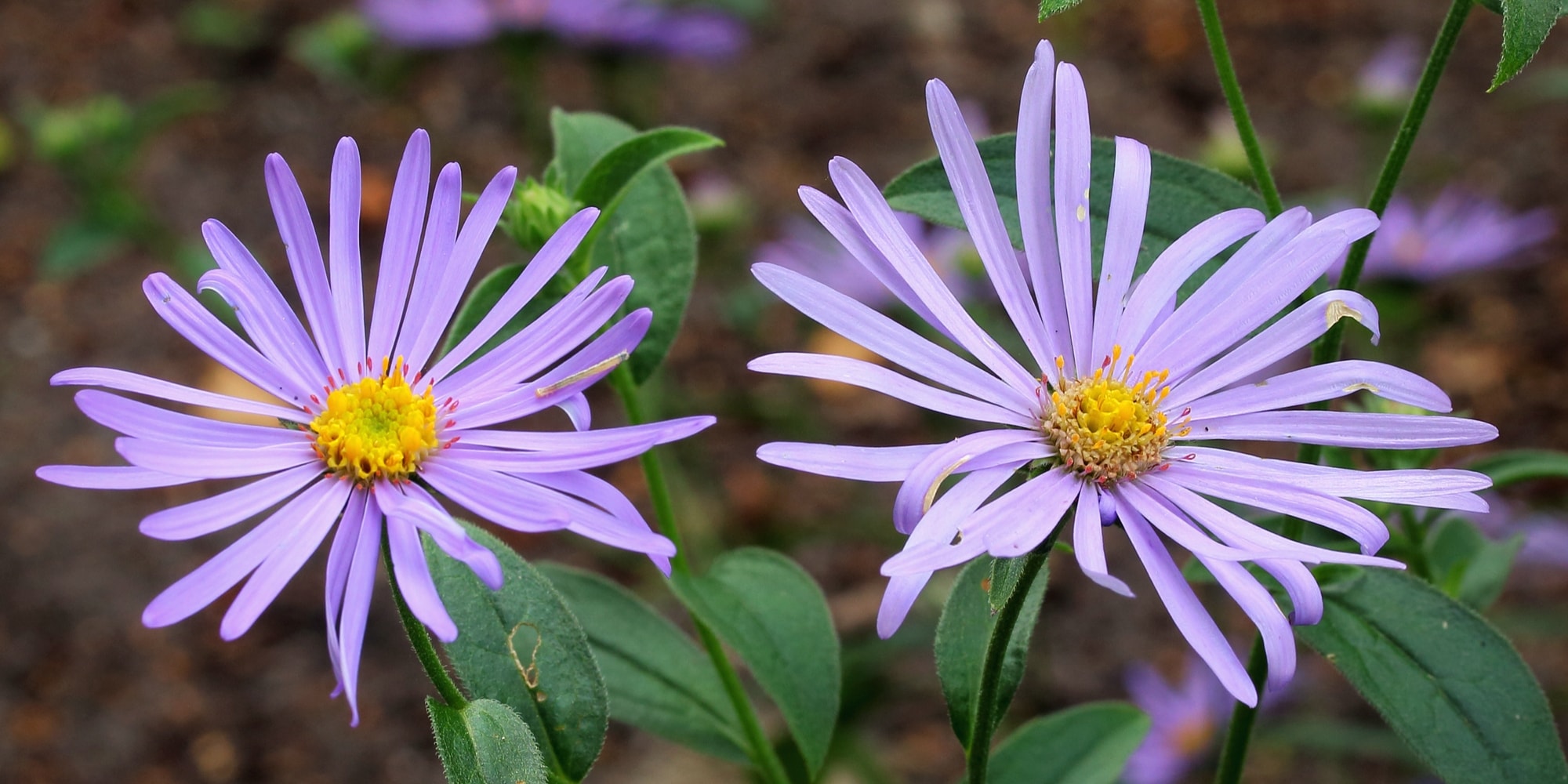
Comments